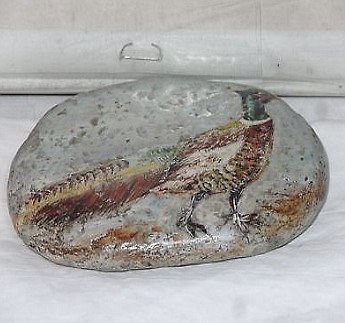CRITTERS OF NORTH IDAHO: The ring-necked pheasant
I was riding in the backseat of my car one day and I saw a gorgeous long-tailed bird with a plump body and fiery copper-red and chestnut brown plumage walking along the road. As familiar as I am with birds, I wasn’t sure what species this one belonged to.
However, I did remember seeing this bird pictured in an animal encyclopedia I’ve had since childhood, and I recall it said the bird is native to China and East Asia. What was it doing in Idaho?
Well, when I got home I did some research and identified the bird as the ring-necked pheasant (Phasianus colchicus). These birds are sexually dimorphic, meaning that their appearance and size differs depending on the bird’s gender.
The bird I saw was a male, and they average 2.6 pounds in weight and 24-35 inches in length, including the tail. Males are more colorful than females, possessing a green head, white collar and a distinctive red wattle (that’s what the fleshy “beard” we also see in chickens is called).
Females (called hens) are smaller and have duller plumage, measuring 20-23 inches in length, weighing around 2 pounds in weight, and they are covered in brown plumage with black speckles, especially over the wings. Ring-necked pheasants are members of the phasianidae family, meaning they are closely related not only to chickens and turkeys, but also the strikingly colorful peafowl.
In the fall, ring-necked pheasants form gregarious flocks that stick together throughout the winter. Like peafowl, turkeys and chickens, these birds can fly, but they spend most of their time walking or running on the ground. They only take off if they feel at risk of predation. That being said, it is most common for them to simply run from danger to the nearest shrubbery.
Usually, flocks of ring-necked pheasants can be found on the lookout for whatever insects, berries, grains and other seeds they can gobble up. This foraging often occurs along rural roadsides (where I saw one), and agricultural fields (usually overgrown or recently harvested) interwoven with areas of taller vegetation they can hide in. In wilder parts of their range with fewer human settlements, they can be found in woodland undergrowth and some wetlands.
In the spring the flocks disperse during the breeding season. At this time, males produce a noisy, cackling display that can be heard from a long way off to attract hens. After mating, hens lay a dozen or so eggs in a nest they construct in fields or in border habitat. Childhood for a ring-necked pheasant is short-lived, as they can fly within two weeks of hatching and leave their mother six or seven weeks later.
In my research, I discovered that these birds are quite common across the United States and southern Canada, and the dream of many a bird-watcher is to find the ring-necked pheasant in the wild. Was my encyclopedia wrong?
It turns out that it wasn’t. See, my encyclopedia said the native range of these pheasants extends from between the Black and Caspian seas, to Manchuria, Siberia, Korea, China and Taiwan. Much like the Appaloosa horses I wrote about a month or so ago, ring-necked pheasants never set foot in the New World until humans brought them here in 1773. It wasn’t just America, either; ring-necked pheasants can now be found in Japan and New Zealand. These birds have become a very successful introduced species, and a welcome addition to our local menagerie of wildlife.
•••
Christian Ryan is a Press correspondent. Email: animaladventures1314@gmail.com
HOMESCHOOL PROJECT
RING-NECKED PHEASANT PAPERWEIGHT
Here is another fun and exciting project for you, painting on rocks or stones. The Ringed-necked pheasant is such a beautiful bird I thought that you might enjoy painting it on a rock or stone instead of paper or canvas.
The possibilities for what you can paint on rocks and stones are endless. They can be used as a paperweight. They can also be turned into a beautiful and unique work of art and placed in a spot where everyone can enjoy seeing it. The only limit to what you can do is your creativity and imagination.
Rocks and stones can be found everywhere, but please be mindful and do not take any rocks from protected land, beaches, or private property.
Different shapes lend themselves to different designs. For example, if a bird is perched you may consider a rock that stands vertical rather than laying flat.
Look for rocks or stones that are smoother in texture. They are easier to paint on than ones that are pitted or rough. Avoid them if they are shiny or polished because paint won’t adhere as well to it. If it is a must-have you should sand it to create some texture and then apply a coat of primer before painting. Bricks and pavers, and other landscaping hardscape materials can be used as well.
MATERIALS NEEDED
Photo of a Ringed-Neck Pheasant
Smooth Rocks or Stones
Acrylic Gesso or Primer
Dish Soap
Water
Scrub Brush or Old Toothbrush
Bucket (to avoid clogging your sink)
Towel or Paper Towels
Acrylic Paint
Paint Brushes (various sizes)
Sandpaper (if necessary)
Wood Filler (for filling in cracks)
Preparation of Rocks or Stones and Steps for Painting
1. Wash rocks or stones with soap and water in a bucket. Scrub with a scrub brush or an old toothbrush to get the dirt off. Dry off with a towel or paper towels and let air dry completely.
2. Sand off any gritty parts with sandpaper if necessary.
3. Prime rocks or stones with one or two coats of acrylic gesso or primer. This will help subsequent layers of paint adhere to the surface and will make the colors appear brighter if the rock is dark.
4. You can smooth wood filler over a rock’s holes, dimples, or cracks to even it out before priming.
5. Once your rock or stone is dry and clean, apply a coat of primer.
6. When the primer is dry you are ready to paint on Ringed-Necked Pheasant.
7. Finally, when all done and the paint is dry, apply sealer to the finished rock painting.
8. Clean up, wash your brushes well with soap and water.
9. Tip: If you leave your brush out too long you can dissolve the dried acrylic paint in your brush with rubbing alcohol or by soaking the brush hairs in Murphy’s Oil for one or two days.
If you have been finding these projects helpful please let us know. We would love your feedback.
Project provided by Angel Dominiq
angeldominiq13@gmail.com





